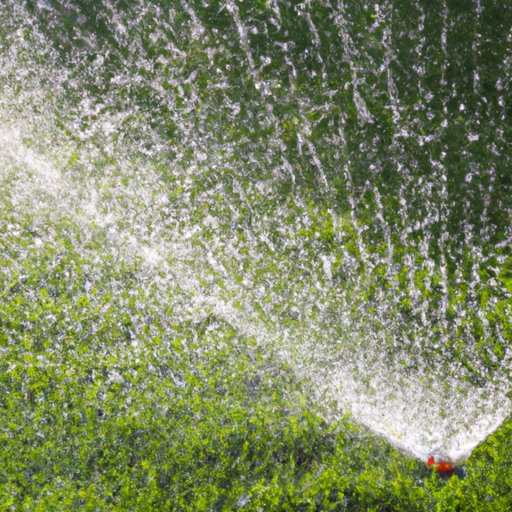Introduction
Watering your lawn is an essential part of keeping it healthy and beautiful. But with so many factors to consider—from seasonal changes to soil moisture levels—it can be hard to know when is the best time to water your lawn. In this article, we’ll explore the science behind when to water the lawn, as well as tips for optimizing your watering routine for a healthy lawn and maximizing water efficiency.
Examining Seasonal Variations in Watering Schedules for Optimal Lawn Care
One of the most important aspects of knowing when to water the lawn is understanding seasonal differences in watering needs. During the summer months, lawns tend to require more frequent watering than in the winter. This is because warm temperatures cause the grass to dry out more quickly, resulting in a need for more frequent watering. It’s also important to note that different climates will have different seasonal variations in watering needs.
To adjust your watering schedule for each season, it’s important to understand the local climate and be aware of any regional weather patterns. For example, if you live in an area that experiences a lot of rain during the spring and summer months, you may not need to water your lawn as often. On the other hand, if your area tends to be dry during those months, you may need to water more frequently.
It’s also important to take into account any regional or local restrictions on lawn watering. Many municipalities have set regulations on when and how much you can water your lawn, so be sure to check with your local government before setting up a watering schedule.

Optimizing Your Watering Routine for a Healthy Lawn
Once you understand the seasonal variations in watering needs, it’s time to optimize your watering routine for the healthiest possible lawn. The first step is to know how much water your lawn needs. This can vary depending on the type of grass, the size of the lawn, and the climate. Generally speaking, most lawns need about one inch of water per week.
Timing is also key when it comes to watering the lawn. Early morning is usually the best time to water, as the cooler temperatures reduce evaporation and allow the water to penetrate deeper into the soil. It’s also important to ensure consistent watering and avoid over-watering, which can lead to shallow root systems and increased weed growth.

The Science Behind When to Water the Lawn
In addition to seasonal variations and timing, there are a few other factors that influence when to water the lawn. One of the most important is understanding soil absorption rates. Different types of soil absorb water at different rates, so it’s important to know how quickly your soil absorbs water and adjust your watering schedule accordingly.
Another factor to consider is the use of a soil moisture meter. These devices measure the amount of water in the soil and can help you determine when to water your lawn. They’re particularly helpful in drier climates, where it’s important to avoid over-watering.
Maximizing Water Efficiency for Lawn Maintenance
One of the most important aspects of lawn maintenance is maximizing water efficiency. There are a few ways to do this, including reducing water usage by using a timer for your sprinkler system and using rainwater collection systems to capture and store rainwater for lawn watering. Smart irrigation technology can also be used to optimize water usage and reduce waste.
Finding the Right Balance of Water and Sunlight for a Perfect Lawn
Another important factor to consider when determining when to water the lawn is the balance between water and sunlight. Too much water can lead to shallow root systems and too little water can lead to drought stress, both of which can be damaging to your lawn. It’s important to find the right balance of water and sunlight to ensure a healthy and vibrant lawn.
Sun exposure can also affect the frequency of watering. If your lawn gets a lot of sun, it may require more frequent watering. On the other hand, if your lawn is mostly in the shade, it may require less frequent watering. Be sure to adjust your watering schedule accordingly.

Understanding the Impact of Temperature on Lawn Watering Schedules
Finally, it’s important to understand the impact of temperature on lawn watering schedules. In general, hotter temperatures require more frequent watering, while cooler temperatures require less frequent watering. This is because warmer temperatures cause the soil to dry out more quickly, resulting in a need for more frequent watering.
It’s also important to determine the right amount of water for different temperatures. Too much water can lead to shallow root systems and too little water can lead to drought stress, both of which can be damaging to your lawn. Be sure to adjust your watering schedule accordingly.
Conclusion
Watering your lawn is an essential part of keeping it healthy and beautiful. To ensure optimal lawn care, it’s important to understand the science behind when to water the lawn, as well as seasonal variations, soil moisture levels, temperatures, and sunlight. Additionally, it’s important to maximize water efficiency and find the right balance of water and sunlight for a perfect lawn.
By following these tips, you can ensure that your lawn stays healthy and vibrant. With proper lawn care, you can enjoy a lush and beautiful lawn for years to come.


